Imagine walking into a yoga studio and your eyes landing on vibrant, detailed designs adorning the walls. These intricate patterns, known as chakra symbols, aren’t just for aesthetic pleasure.
They represent a profound spiritual and psychological system that illustrates how the universe operates within us. Embodied in these symbols are complex concepts about energy, consciousness, and our divine potential, making them much more than just eye-catching designs.
In this article, we will discuss 7 main chakra symbols and how you can connect your mind, body, and soul to these symbols to enhance your energy system.
What is Chakra?
The concept of chakras originates from ancient Indian spiritual traditions. The term “chakra” is derived from Sanskrit, signifying “wheel” or “disk.” In the realm of spiritual energy, chakras are visualized as spinning vortexes of energy that form the nexus between our body, mind, and soul. They represent the life force, or prana, that circulates within us.
From the base of our spine to the crown of our head, these chakras correspond to significant nerve centers in our body, governing various physical, emotional, and spiritual aspects of our lives. Each of the seven main chakras carries a unique vibration and symbolic meaning.
History of Chakra Symbols
Chakra symbols have deep historical roots in the ancient Tantric texts of India, where each chakra was portrayed with a unique symbol. These symbols served as a spiritual guide, representing the vibrational frequency, function, and effects of each individual chakra. They express the dynamic energy pattern that is characteristic of each chakra, helping us visualize and understand their energetic properties.
Chakra symbols are vibrantly colored, embodying the unique energy frequency and impact of each chakra. From red, symbolizing the grounding energy of the Root Chakra, to violet or white, representing the universal consciousness of the Crown Chakra, these colors are an integral part of chakra symbolism, offering us a visual guide to understanding these energy centers.
The Symbolism and Sacred Geometry of Chakra Symbols
The complex design of chakra symbols incorporates elements of sacred geometry, a form of spiritual symbolism seen in many cultures worldwide. The power diagrams, like the Mandala and Yantra, are composed of intricate arrangements of shapes such as circles, squares, triangles, and lotus petals. These geometric configurations are seen to symbolize the universe, the divine, and the energy fields of deities, offering us a way to visualize the structure of existence.
The Purpose of Sacred Geometry
These geometric symbols provide a sacred space that bridges the gap between the inner and outer worlds, the human and divine. They serve as tools to aid meditation, helping us focus our consciousness and explore our inner spiritual landscape.
Circular Design of Chakra Symbols
The chakra symbols are circular in design, a shape imbued with profound symbolism across various cultures. A circle represents wholeness, unity, and infinity – with no beginning or end, it is a symbol of the cyclical nature of life and the infinite nature of energy.
The Significance of the Lotus Flower
The lotus flower is another essential element seen in chakra symbols. In spiritual traditions, it represents spiritual awakening and enlightenment – the blossoming of the inner self in connection to the divine. As the lotus rises from the mud to bloom under the sun, it symbolizes our journey from spiritual ignorance to wisdom.
The 7 Main Chakras Symbols and Their Meaning
Let’s have a closer look at the main chakra symbols and their meaning:
1. Root Chakra (Muladhara)
- Element: Earth
- Color: Red
- Meaning: Stability, security, grounding
- Symbol: Square, four petals, elephant, lotus
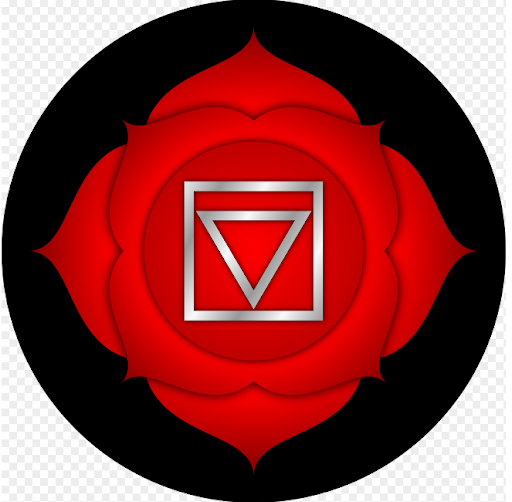
The symbol of the Root Chakra is a magnificent four-petaled lotus enclosed in a protective square. This symbol carries profound meaning, as each element contributes to its significance. The red color represents the grounding earth element, emphasizing our connection to the physical world and anchoring us in stability and strength.
The four petals symbolize the foundational aspects of this chakra, which include our basic survival instincts, physical health, and overall stability.
2. Sacral Chakra (Svadhisthana)
- Element: Water
- Color: Orange
- Meaning: Creativity, sexuality, pleasure
- Symbol: Crescent moon, six petals, crocodile, lotus

The Sacral Chakra’s symbol features an orange six-petaled lotus intertwined with a crescent moon. This captivating symbol holds deep meaning, conveying the essence of this chakra’s energies. The vibrant orange color stimulates our passion and creativity, while the lotus petals symbolize the multifaceted aspects of our emotional well-being.
The crescent moon signifies the ebb and flow of our emotions and the ever-changing nature of our sexual energy, inviting us to embrace emotional balance and harness our creative potential.
3. Solar Plexus Chakra (Manipura)
- Element: Fire
- Color: Yellow
- Meaning: Personal power, self-confidence, will
- Symbol: Ten petals, sun, lion, lotus
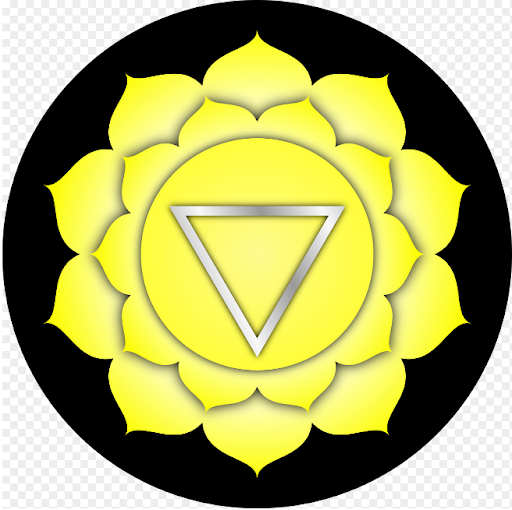
The symbol of the Solar Plexus Chakra is a radiant yellow ten-petaled lotus with a downward-pointing triangle. This powerful symbol encompasses the core attributes of this chakra. The yellow color symbolizes the fire element, fueling our personal power, ambition, and self-esteem.
The lotus petals represent the expansive nature of our personal growth and transformation. The downward-pointing triangle symbolizes the downward flow of energy, anchoring us to our personal power and encouraging us to radiate confidence and self-assurance.
4. Heart Chakra (Anahata)
- Element: Air
- Color: Green
- Meaning: Love, compassion, empathy
- Symbol: Twelve petals, two triangles, dove, lotus
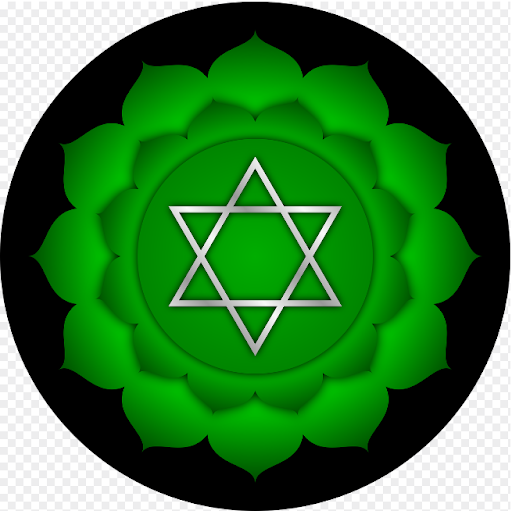
The symbol of the Heart Chakra is a green twelve-petaled lotus containing two intersecting triangles. This symbol embodies the profound qualities of love, compassion, and emotional balance. The green color resonates with the energy of nature, symbolizing harmony, healing, and growth.
The twelve lotus petals signify the nurturing aspects of this chakra, inviting us to cultivate loving relationships, extend compassion to others, and harmonize our emotions. The intersecting triangles represent the integration of our inner and outer worlds, forging a deep connection between love, compassion, and the equilibrium of the heart.
5. Throat Chakra (Vishuddha)
- Element: Ether
- Color: Blue
- Meaning: Communication, truth, expression
- Symbol: Sixteen petals, lotus, thunderbolt
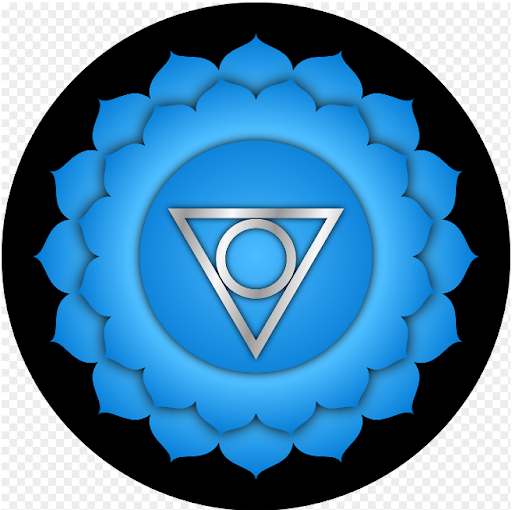
The symbol of the Throat Chakra is a blue sixteen-petaled lotus. This enchanting symbol embodies the power of communication, self-expression, and truth. The blue color evokes a sense of calm and clarity, encouraging us to speak our authentic voice and share our truth with integrity.
The sixteen lotus petals symbolize the multifaceted aspects of communication and self-expression, inviting us to articulate our thoughts, ideas, and emotions in a harmonious and authentic way.
6. Third Eye Chakra (Ajna)
- Element: Light
- Color: Indigo
- Meaning: Intuition, wisdom, insight
- Symbol: Two petals, lotus, third eye
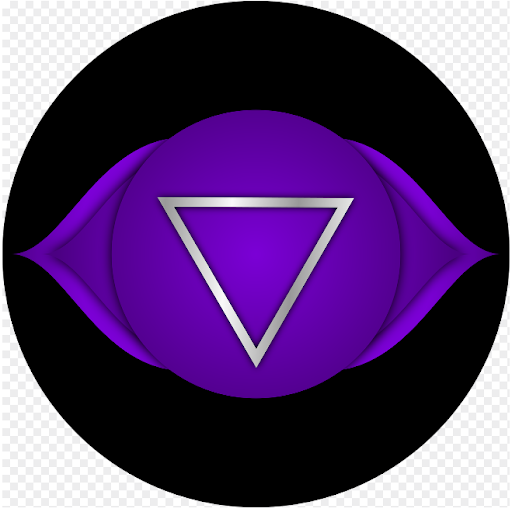
The symbol of the Third Eye Chakra is an indigo two-petaled lotus with an inverted triangle. This profound symbol represents intuition, wisdom, and the ability to perceive the bigger picture. The indigo color deepens our connection to inner wisdom, expanding our awareness beyond the confines of the physical world.
The two lotus petals symbolize the duality of our perception, inviting us to awaken our intuitive abilities and embrace the wisdom that comes from looking within. The inverted triangle represents the descent of divine knowledge and the opening of the third eye, allowing us to see beyond the surface and access higher realms of consciousness.
7. Crown Chakra (Sahasrara)
- Element: None
- Color: Purple
- Meaning: Enlightenment, oneness, connection
- Symbol: Thousand petals, lotus, om symbol
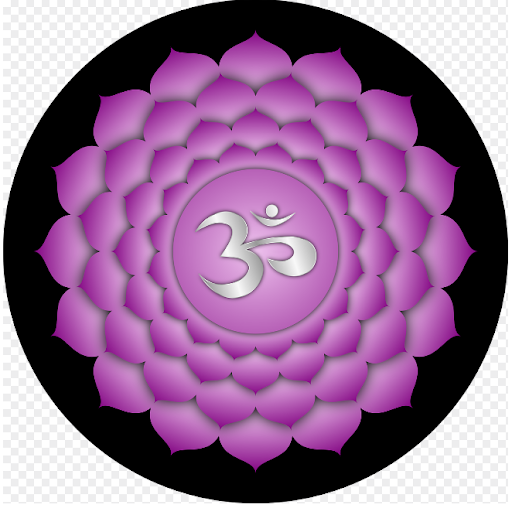
At the pinnacle of our chakra journey, the symbol of the Crown Chakra is a violet or white thousand-petaled lotus. This symbol represents spiritual connection, enlightenment, and the realization of universal consciousness.
The violet or white color reflects the highest realms of spirituality, inviting us to transcend the boundaries of the ego and merge with the divine. The thousand lotus petals symbolize infinite possibilities, representing the expansive nature of our spiritual journey and the profound unity of all beings.
How to Use Chakra Symbols?
Here’s how you can work with chakra symbols:
- Learn about the seven chakras and their associated physical and emotional attributes.
- Obtain a set of chakra symbols, either by purchasing them or drawing them yourself.
- Find a quiet and comfortable place to meditate.
- Choose a chakra symbol to focus on during meditation.
- Close your eyes and take several deep breaths to relax your body.
- Visualize the corresponding chakra and its energy flowing through your body as you focus on the chakra symbol.
- Repeat this process with each chakra symbol, focusing on one at a time.
- During yoga practice, place the chakra symbol in the corresponding location on your body.
- Consider placing chakra symbols in your home or workspace as a way to promote balance and positive energy.
- Repeat
Remember that chakra symbols are not a substitute for medical treatment or therapy. If you are experiencing physical or emotional symptoms, seek professional help.
How to Balance Your Chakras?
Balancing chakras involves a variety of techniques that can help align your body’s energy system. Here are some ways to balance your chakras:
1. Diet
Eating a balanced and healthy diet can help balance your chakras. Focus on eating whole, unprocessed foods and avoiding foods that are high in sugar, salt, and fat. The best way to maintain a healthy body is by incorporating high-vibrational foods into your diet.
2. Mudras
Mudras are hand gestures that can help balance the flow of energy in your body. Each mudra is associated with a specific chakra. For example, the Gyan mudra is associated with the third eye chakra, while the Prithvi mudra is associated with the root chakra.
3. Breathing
Breathing exercises can help you balance your chakras by increasing the flow of oxygen to your body. Try practicing pranayama, a series of breathing exercises that can help you balance your energy.
4. Asana
Yoga poses, or asanas can help you balance your chakras by stimulating and opening the different chakras in your body. Poses such as the mountain pose, tree pose, and warrior pose can help you balance your root chakra, while poses such as the camel pose and cobra pose can help you balance your heart chakra.
5. Meditation
Meditation is a powerful tool for balancing your chakras. By focusing your attention on each chakra, you can help release any blockages and restore the flow of energy. Try sitting quietly and focusing on each chakra, starting with the root chakra and moving up to the crown chakra.
Related read:
Conclusion: Chakras Symbols
The seven chakra symbols provide a visual representation of the energy centers within our bodies. Each symbol carries a unique meaning and significance, offering guidance and insight into our spiritual journey.
By understanding the chakra system and incorporating chakra symbols into our lives, we can cultivate balance, healing, and self-awareness. Embrace the power of the chakra symbols and embark on a transformative path of personal growth and enlightenment.
FAQs: Chakras Symbols
What is the purpose of chakra symbols?
Chakra symbols serve as visual representations of the energy centers in our bodies. They help us connect with and understand the qualities associated with each chakra, supporting our spiritual growth and self-awareness.
Can I use chakra symbols for meditation?
Absolutely! Chakra symbols can be used during meditation as objects of focus or visualizations. They can help deepen your meditation practice and facilitate chakra healing and balancing.
How do I know if my chakras are imbalanced?
Imbalanced chakras may manifest as physical, emotional, or spiritual issues. Common signs include physical ailments, mood swings, lack of motivation, and feeling disconnected. Energy healers or practitioners can provide further insight and assistance in balancing your chakras.
Are chakra symbols associated with any specific religion?
Chakra symbols have their roots in ancient Eastern traditions such as Hinduism and Buddhism. However, they are not limited to any specific religion and can be embraced by individuals of various spiritual paths.
Where can I find authentic chakra symbol jewelry?
Authentic chakra symbol jewelry can be found in specialized spiritual or metaphysical stores, online marketplaces, or through artisan jewelers who specialize in creating energy-infused jewelry.
